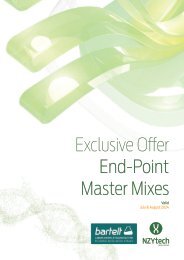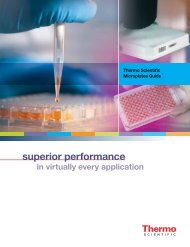PeloBiotech
Create successful ePaper yourself
Turn your PDF publications into a flip-book with our unique Google optimized e-Paper software.
www.pelobiotech.com<br />
Safety Tools<br />
Research from the FDA, ATCC, and others show that 5 % - 30 % of all cell cultures today are contaminated with<br />
mycoplasma. Mycoplasma contamination in cell culture can have profound effects on cellular behavior, leading to skewed<br />
experimental outcomes and jeopardizing the reliability of research findings. Mycoplasma are known to alter various<br />
cellular functions, including metabolism, proliferation, and gene expression. They can induce changes in cell morphology,<br />
disrupt cell cycle progression, and even trigger apoptosis. These alterations can confound experimental results, making it<br />
challenging to draw accurate conclusions about the impact of specific treatments or conditions on cells. Mycoplasma<br />
contamination can compromise the reproducibility of experiments, hindering the ability to validate and build upon<br />
scientific findings. By implementing stringent safety tools and practices, researchers aim to create a microenvironment<br />
that minimizes the risk of mycoplasma contamination, thus ensuring the fidelity of cell culture experiments and the<br />
reliability of scientific research. Adhering to strict sterile techniques, such as using sterile pipettes, gloves, and culture<br />
hoods, further reduces the likelihood of introducing contaminants. These safety measures are imperative not only for<br />
maintaining the scientific validity of cell culture experiments but also for safeguarding the well-being of researchers and<br />
preventing the spread of contaminants within the laboratory environment.<br />
Save time and ensure the integrity of your research with our meticulously curated cell lines—mycoplasma, virus, and<br />
contamination-free. Elevate your experiments with the confidence that comes from starting with pristine cells,<br />
allowing you to focus on groundbreaking discoveries rather than constant testing. Your research deserves the purity it<br />
needs, and our cell lines deliver reliability straight out of the vial.<br />
Mycoplasma Detection and Elimination Kits<br />
• BioMycoX Mycoplasma Elimination Kit: Designed to eliminate mycoplasma contamination from cell cultures,<br />
ensuring the integrity of experiments and cell lines.<br />
• BioMycoX Mycoplasma PCR Detection Kit: Provides a PCR-based method for the detection of mycoplasma<br />
contamination in cell cultures.<br />
• BioMycoX Mycoplasma qPCR Detection Kit: Utilizes quantitative PCR (qPCR) to detect and quantify<br />
mycoplasma contamination.<br />
• HiSense Mycoplasma PCR Detection Kit: Specifically designed for the PCR-based detection of mycoplasma<br />
contamination.<br />
• MycoQsearch Mycoplasma qPCR Detection kit EP: Offers a highly sensitive qPCR detection kit for mycoplasma,<br />
complying with European Pharmacopoeia (EP) standards.<br />
• MycoQsearchTM Plus Mycoplasma qPCR Detection kit EP (NEW_Dual Probes included for crosscontamination<br />
checking): This advanced qPCR kit includes dual probes to check for cross-contamination and<br />
meet EP standards.<br />
• SafeDry Mycoplasma PCR Detection Kit (8 strip x 6 ea): A mycoplasma PCR detection kit provided in an 8-<br />
strip format for convenient use.<br />
Mycoplasma Prevention and Contamination Products<br />
• BioMycoX Mycoplasma Prevention Spray (1L): Designed to prevent mycoplasma contamination in the<br />
laboratory environment, providing an additional layer of protection.<br />
43
















